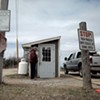Published January 8, 2014 at 1:27 p.m.
When North Bennington residents voted to shutter their public school, it wasn’t because of rising teacher pay or declining test scores. Far from it: They were worried the state would close or consolidate the small, kindergarten-through-sixth-grade school in their town of 1,500. So they preempted fate and made it private. The school district now pays tuition for North Bennington children to attend the new Village School.
“The reason we walked down this path was we wanted to sustain the school as it was, at the heart of the community, providing the service that it does to our district’s children,” says Ray Mullineaux, a 14-year veteran of the Prudential Committee, which governs the public school district. “We wanted to maintain local control, and we wanted to retain the climate and character and quality of the school.”
For their part, state officials say North Bennington had no reason to believe its elementary school’s days were numbered — and the town’s course of action could have unintended consequences.
“Basically what they did is turn over complete control of the school to a body that is not answerable to the public,” says outgoing Vermont Secretary of Education Armando Vilaseca.
“They made a local decision to give up local control, and that’s ironic in a way,” suggests Vilaseca’s successor, Rebecca Holcombe.
In wresting that control from the local supervisory union and state education officials, North Bennington kindled a statewide debate about the role of independent schools in Vermont. Vilaseca, who leaves his post this month, condemned North Bennington’s move in a report released in December and strongly suggested state lawmakers forbid any future privatization of public schools.
Further, Vilaseca is recommending some major changes to the way Vermont treats independent schools — many of which receive public dollars to educate students who are “tuitioned” in from communities without public schools of their own. Vilaseca argues that independent schools receiving public funds should provide free and reduced lunch programs. He wants private schools with publicly funded enrollments of 25 percent or more to provide the same services, and meet the same guidelines, as public schools, and is urging the legislature to repeal a provision in state law that allows communities to approve higher tuition rates for independent schools.
Advocates of independent schools are fighting back. They say Vilaseca hijacked the summer study committee that was supposed to report back to the legislature on the state and local implications of public schools closing and going independent. Seth Bongartz, the chair of Burr and Burton Academy’s board of trustees, said Vilaseca was “contemptuous of the process, of the legislative directive, of our time … That report was essentially written before we ever thought about meeting.”
Fran Bisselle, the head of Manchester’s Maple Street School was also on Vilaseca’s summer study committee. “It felt like the process was really inclusive and the product was really exclusive,” she says, noting the resulting report falls short of the original charge: to help legislators make informed decisions about independent schools.
Vilaseca states clearly in the controversial December 5 report that its recommendations are his own and not reflective of the committee — that was always his intention, he claims. In response, five members of the committee representing independent schools authored a dissenting report, urging against “unnecessary legislation” and arguing that it is “wise for Vermont to not only keep school choice where it is, but to look to expand it to all districts, positioning our state to be a national leader in education.”
“Of course,” independent schools are concerned when officials such as Vilaseca put the spotlight on their practices, said Mill Moore, executive director of the Vermont Independent Schools Association. “Everybody’s worried about the cost of education. Money is important right now.”
An estimated $34.6 million in public funds went to independent academic institutions last year. When North Bennington opted to close its school, it became one of 91 towns in Vermont that let families decide where to send their children to school — and financed their choices with taxpayer dollars. Roughly 11 percent of Vermont’s K-12 students attend independent schools; that number, provided by VISA, includes children whose parents elect to pay tuition as well as those whose tuition bills are covered by towns that don’t operate schools.
Most funded students attending independent schools are in middle or high school; few towns “tuition out” elementary school kids. Around 2,500 students attend Vermont’s four town academies, which are private institutions that act like the de facto public schools in their communities. Some date back more than 100 years, and none turn away students who hail from the towns they serve. State officials are quick to say that their concerns about the North Bennington scenario don’t extend to these academic institutions.
Moore doubts that many other districts would go to the lengths that North Bennington has to change its school structure. But he says that doesn’t mean all Vermont school districts are happy with the status quo.
“I do think some small districts are looking at this,” says Moore. “They feel left out. They feel unsupported … [They have] legitimate concerns and they’re not getting much respect.”
Same School, Different Structure
North Bennington’s primary school doesn’t look much different today than it did this time last year. The public school officially closed on the last Friday in June 2013, and reopened as an independent school the following Monday morning. Students returned to the building on September 4.
Students still settle in for classes in the same stately brick schoolhouse that dates back to the late 19th century. Even classroom instruction remains largely unchanged: Students here still take standardized tests, and teachers adhere to the new “Common Core” standards in place at public schools throughout Vermont.
Though most of the teachers chose to stay through the transition, they did so only after being technically laid off by the local school district and rehired by the independent school; their salaries and benefits stayed the same, but they no longer have union contracts or representation.
The change can be seen in the office of Thomas Martin — a former principal, now headmaster, who spent 40 years in public education. Martin is now running what amounts to a small business. He oversees payroll, internet services, building and maintenance issues — basically, anything and everything previously handled by the supervisory union.
His office is part workplace, part Willy Wonka concoction. There’s a tabletop popcorn machine in one corner, and athletic pendants line the walls. Kites and brightly colored whirligigs dangle from the ceiling. On a snowy winter morning, the radiator sends up a rattle of jarring clangs, bangs and rattles.
Since coming on as North Bennington’s principal in 2006, Martin has watched the town grapple with decisions about the school’s future. He ticks off a laundry list of committees and special study groups that looked into the bigger picture of school sustainability, then more specifically into the idea of going independent. He calls the final proposal “one of the most carefully vetted” he’s ever seen. And though he had reservations initially about the plan — he cites “certain stereotypes” that get attached to private schools, such as kids in blazers — he came to support the idea.
After North Bennington voters approved it — “overwhelmingly,” Martin says now, by roughly 80 percent — state education officials took notice. First came a phone call from Vilaseca, voicing concerns about the vote, followed by discouraging meetings in Montpelier. Then the Vermont Board of Education delayed the approval of the new independent school, pushing back the timeline for North Bennington’s shift and triggering two more revotes in the process.
Martin says the he knew the town would get resistance from officials — “bureaucracies don’t like outriggers,” he says — but he was taken aback by the year-and-a-half-long struggle.
The good news? He says all is proceeding relatively smoothly at the new independent school. After years of talk about offering language instruction, the school is partnering with students from Bennington College to provide it. What wasn’t possible before — because of employment contracts, and requirements that the supervisory union offer similar programming at all of its schools — happened in a matter of mere months at the Village School.
“I have more flexibility and freedom to do what’s best for our school,” says Martin.
Outside, kids are squealing gleefully during their mid-morning recess. When Martin ducks outside to speak with a colleague, a small boy chides him, “Mr. Martin! Put on a coat!” The snow is coming down heavier. A few of the older children have commandeered sleds, which they surf down a small slope on the playground.
Sixth-grade teacher Pat Gibbons, a 35-year veteran at the school, ushers her pink-cheeked, snow-dampened charges back inside, where the students settle down for a period of silent reading.
North Bennington educated 170 students a year when Gibbons started as a teacher here. At one point during her tenure, there were as many as 190 kids in the building, and she’s seen numbers dip as low as 116. That’s not tiny, by Vermont standards, but community members still worried about the enrollment trends.
“In this age of downsizing, it’s logical to assume that a small village school will have to struggle to save its identity,” she says. “We have a very special village school that we wanted to retain.”
North Bennington was the second community in Vermont to close its public elementary school and reopen a privately run one in its place. The first, Winhall, closed its public school in 1998 amid complaints about per-pupil costs — they were the highest in the state of Vermont at the time — and the quality of education.
Fifteen years later, North Bennington’s decision was based on very different reasons. Formerly known as the North Bennington Graded School, the elementary school and its teachers are beloved in the community. Advocates for going independent hoped that liberating the school from the restrictions of public education would help keep it afloat in years to come. There’d be the possibility of fundraising, for instance, and of attracting students from neighboring communities whose parents might be willing to pay tuition.
“This model is not a panacea,” says Martin. “It doesn’t make the problems and challenges we were facing go away. It does give us some control.”
There’s still a public school district in North Bennington, but now it pays tuition — $12,938 per pupil this year — to the Village School instead of operating its own K-12 learning facility. The Village School, in turn, leases its brick schoolhouse from the district for $78,000 a year. After they graduate from sixth grade, Village School students go on to attend the public Mount Anthony Union Middle and High schools.
Losing Local Control?
That North Bennington’s Village School survived its first semester hasn’t assuaged the concerns of state officials and lawmakers.
In his report to lawmakers, Vilaseca argues that a community’s decision to take a public school private poses some potential problems for the town. Vilaseca is concerned that the switch to independent status will limit the educational opportunities for some students. The school provides special-education services for all eligible current students, but there’s no guarantee, Vilaseca says, that it will continue to do so in the future.
Mullineaux says that’s just not true. He says North Bennington’s independent school has pledged to provide special-education services for any child that it can reasonably accommodate in the building. If a student were so severely disabled that he or she couldn’t be accommodated, the public school district would fund a student’s placement in a specialized program — but that’s always been the case, and happens in towns that operate public schools, too.
“There really isn’t a public school in the state that can take every student with every disability,” says Mullineaux.
Meanwhile, officials say there’s also a potential financial cost when it comes to going independent: While the Agency of Education says it’s too early to know the financial impact on taxpayers, the switch means the town loses direct control of the independent school’s budget. Districts that operate public schools can drill down deep, every year, into the line items of their school budgets. North Bennington voters won’t have that option.
Looking at the big picture, though, the way the town funds education won’t change; North Bennington will still pay property taxes for education to Montpelier, and receive money back depending on the tuition budget voters approve. North Bennington, like all towns in the Southwest Vermont Supervisory Union, is considered a “receiving” district under the statewide system that funds education and is designed to spread the wealth between rich and poor communities. That means the town gets back more for education than it contributes in property-tax dollars.
“It’s clear that these people care very deeply about their children,” says Holcombe. But she says she’s still concerned that “maybe this decision hasn’t been fully thought out.” The town is still liable and responsible for educating all of its children, she says, but North Bennington has “given up control without responsibility.”
In response, independent school advocates say there is a different kind of accountability at their schools; if parents don’t like the way a school is run, or aren’t happy with the results of their child’s education, they can leave. Already, Martin says, he’s fielding phone calls from parents of next year’s kindergarteners. The question isn’t when those children will enroll at his school, but if. In theory, that competitive pressure should keep the school on its toes.
“The most powerful voice the community has here is choice,” says Martin.
But public schools serve more than just children and families, argues Rep. Johannah Donovan (D-Burlington), the chair of the House Education Committee. Donovan introduced legislation last year that would have prevented further school conversions like the one in North Bennington. The bill didn’t pass, but Donovan and other lawmakers are gearing up for another conversation about independent schools in the 2014 legislative session.
“The schools in Vermont do not exist for parents. They exist for the community and for the good of all of us,” says Donovan. “They exist because of a common need to develop good citizens, good employees, good family people.”
Donovan says her critique of what happened in North Bennington isn’t an attack on independent schools. But she supports the idea of further investigating Vermont’s unusual school-choice system, particularly in cases where independent schools are receiving significant taxpayer money. In those cases, she believes, like Vilaseca, that schools should “have to play within the same sort of rules that other institutions do that take public dollars” — think school lunch, services for children with disabilities and other programs mandated for public schools.
Mullineaux isn’t worried about North Bennington shortchanging its students. He says that any community that goes to the lengths his did is going to be “committed to doing the right things for kids.”
“I think that if local control is to mean anything, you have to trust the communities to make these decisions for themselves about how they want to provide education for their children,” says Mullineaux. “You have to enable them, not stand in the way of them.”
More By This Author
Speaking of...
-

At the Junction of State and Federal Law, I-91 Checkpoint Becomes Site of Legal Collision
Feb 5, 2014 -

Maple Makeover? Vermonters Discover a New Sugaring Technique
Feb 5, 2014 -

Disharmony on Prospect Street: A Dispute Between Neighbors Strikes a Sour Note
Feb 5, 2014 -

Treatment or Trial? Growing 'Rapid-Intervention' Program Gives Addicted Offenders a Choice
Jan 29, 2014 -

Raw Deal? Farmers Push Back Against Unpasteurized Milk Regulations
Jan 29, 2014 - More »
Comments
Comments are closed.
From 2014-2020, Seven Days allowed readers to comment on all stories posted on our website. While we've appreciated the suggestions and insights, right now Seven Days is prioritizing our core mission — producing high-quality, responsible local journalism — over moderating online debates between readers.
To criticize, correct or praise our reporting, please send us a letter to the editor or send us a tip. We’ll check it out and report the results.
Online comments may return when we have better tech tools for managing them. Thanks for reading.















































